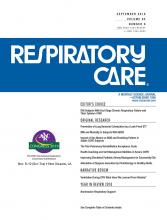Obesity is more and more prevalent in industrialized countries and, to a lesser extent, in developing countries.1 It is a worldwide public issue for health-care practitioners in numerous clinical activities as well as for public health decisions.2,3 Obesity affects many aspects of the care delivered to the patient. Among these aspects, mechanical ventilation may be one of the most challenging to handle, either in the operating theater or in the ICU. This could be of particular importance for patients with both severe obesity and ARDS, a population in which only limited data are available.4
In the current issue of Respiratory Care, Tlayjeh et al5 present very valuable results of a post hoc analysis of the OSCILLATE trial, focused on the impact of body mass index (BMI) on the mortality of subjects with ARDS. The OSCILLATE trial included 548 subjects with moderate or severe ARDS, randomized either to a conventional high-PEEP ventilation strategy or to high-frequency oscillatory ventilation.6,7 Overall, no differences in mortality rates were observed across all BMI strata. Moreover, the association of high-frequency oscillatory ventilation with in-hospital mortality was not affected by BMI strata. The study had some limitations as acknowledged by the authors. Mainly, only 82% of the subjects enrolled in the OSCILLATE trial could be included in the post hoc analysis and patients who were obese and with an actual body weight of >1 kg per centimeter in height were excluded from the OSCILLATE trial.5
The fact that subjects with ARDS and who were obese (BMI, 30–39.9 kg/m2) and severely obese (BMI > 40 kg/m2) had similar mortality rates to subjects with ARDS and of normal weight is very important because it confirms previous results from other groups.8–11 From our point of view, such a result should not imply that patients who are obese should be uniformly managed as patients with ARDS of normal weight, but as an opportunity to develop personalized ventilatory strategies that aim to specifically improve the prognosis of patients with combined ARDS and obesity. Indeed, one should keep in mind the very specific mechanics of such patients as well as results of a post hoc analysis of the ALVEOLI study,10 which demonstrated a benefit of a high-PEEP strategy in subjects with ARDS who were obese.
Patients with ARDS who are obese and severely obese are characterized by excessively high pleural pressures, which leads to negative transpulmonary pressures, whereas chest-wall compliance remains generally within the normal range.4 Because pleural pressure can be estimated by monitoring esophageal pressure, it provides a good opportunity to test the hypothesis that PEEP settings that aim to obtain a positive end-expiratory transpulmonary pressure could improve the prognosis of patients with ARDS who are obese or severely obese. Furthermore, from a safety perspective, such esophageal pressure monitoring allows calculation of the end-inspiratory transpulmonary pressure (as a reflect of the posterior dependent lung areas, submitted to the weight of the damaged lung) and end-inspiratory transpulmonary pressure estimated from the elastance ratio of the chest wall to the respiratory system (as a reflect of the anterior nondependent lung areas, not submitted to the weight of the damaged lung), even if the latter has not been fully validated in patients with ARDS and who are obese and severely obese.12
It was recently shown that titrating PEEP with an esophageal pressure-guided strategy was not associated with a mortality benefit compared with an empirical high-PEEP strategy (derived from the OSCILLATE trial) in a general ARDS population.13 Interestingly, the mean actual body weight was 84.0 (72.0 to only 105.0) kg in the experimental group (esophageal pressure-guided strategy), with a mean PEEP level difference between the 2 groups of only 1.5 cm H2O. One can suppose that an esophageal pressure-guided strategy could have led to more positive clinical results in a homogeneous group of subjects with ARDS who were obese or severely obese, perhaps defined by a BMI lower limit of 35 or 40 kg/m2.
Another important feature to take into account is the frequent occurrence of an airway closure phenomenon in patients who are obese and severely obese.14 Setting PEEP above the airway opening pressure, if present, could lead to more exact calculations of expiratory transpulmonary pressures as well as to avoid cyclic small airways closing and reopening. Beside esophageal and airway pressure monitoring, electrical impedance tomography could be of great interest in patients with ARDS who are obese and severely obese, both for measuring global and regional changes in lung volume in response to different PEEP settings and also to detect or confirm an airway closure phenomenon.4,15
Also, it is conceivable that the pattern of body-fat distribution (abdominal vs general) could also be an important factor to take into account, in addition to the absolute BMI value. In this way, monitoring of abdominal pressure in response to various respiratory settings could be a means to avoid an excessive rise in patients with low abdominal compliance.16 Such a monitoring can be achieved by means of either gastric or bladder pressure monitoring.
We now have the opportunity to better analyze, at the bedside, the respiratory mechanics and ventilation of patients with ARDS who are obese and severely obese. Such monitoring could help implement personalized mechanical ventilator settings and evaluate, on a large scale, specific ventilator strategies that aim to improve the prognosis of such patients with ARDS. If such monitoring is not available at the bedside, then clinicians should be strongly encouraged to use high-PEEP strategies in patients with ARDS who are obese and severely obese.
Footnotes
- Correspondence: Jean-Luc Diehl MD, Medical Intensive Care Unit, Hôpital Européen Georges Pompidou, Assistance Publique-Hôpitaux de Paris, 20 Rue Leblanc, 75015, Paris, France. E-mail: jean-luc.diehl{at}aphp.fr.
The authors have disclosed no conflicts of interest.
See the Original Study on Page 1042
- Copyright © 2019 by Daedalus Enterprises







